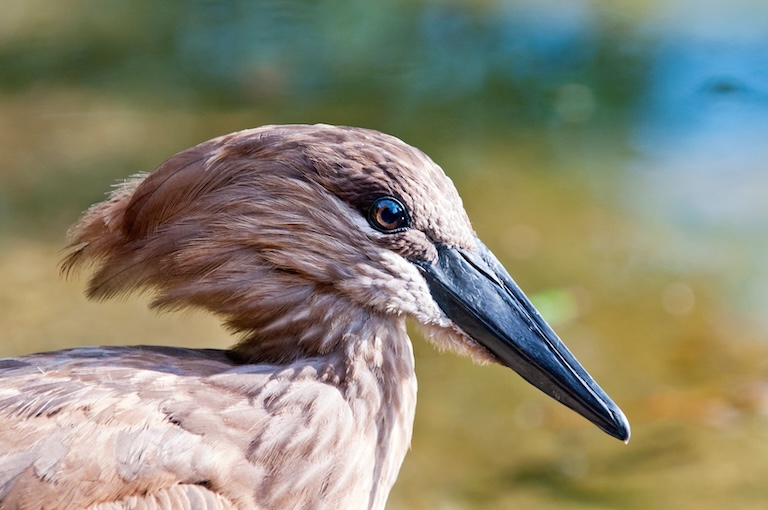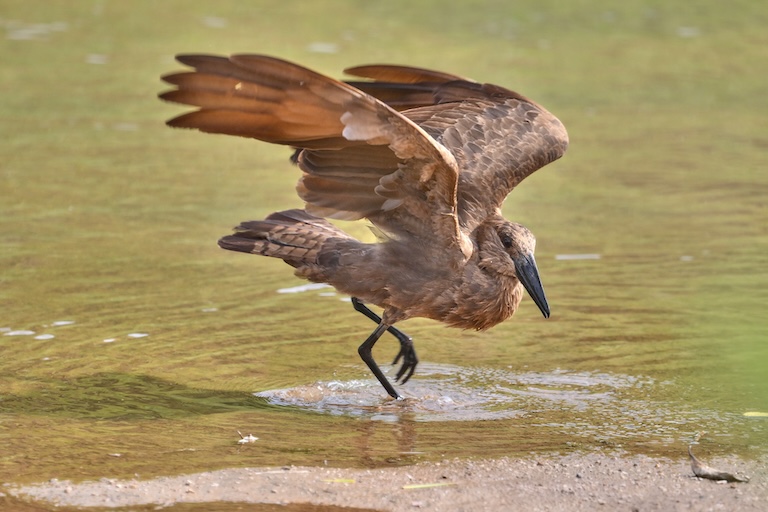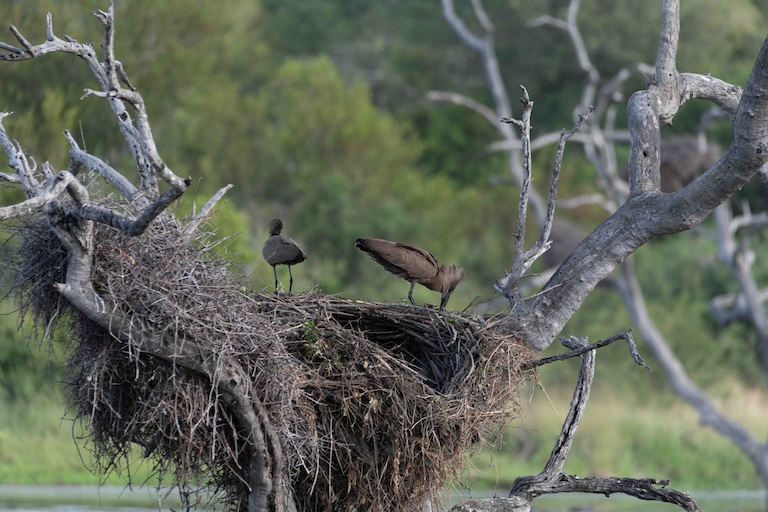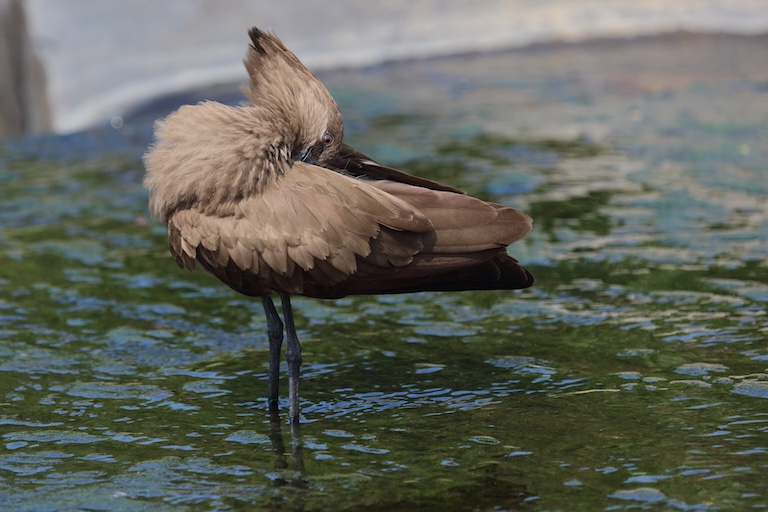Hamerkop Profile
What the Hamerkop is, is an enduring mystery. Some call it Africa’s smallest stork. It’s described as an ibis-like bird, and it’s often grouped with herons and egrets (which are just flashy herons).
Its name translates from Afrikaans to “Hammer head” which groups it firmly within the inanimate hand tool family but this isn’t taxonomically sound, either.
So, what in the world is it?

Hamerkop Facts Overview
| Habitat: | Wetlands: rivers, marshes, lake edges, boggy forest, sometimes coastal |
| Location: | Sub-Saharan Africa |
| Lifespan: | Not recorded |
| Size: | 56 cm (22 in) long |
| Weight: | 470 g (17 oz) |
| Colour: | Brown |
| Diet: | Amphibians, invertebrates, reptiles, possibly small mammals |
| Predators: | Monitors, snakes, raptors |
| Top Speed: | Unknown |
| No. of Species: | 1 |
| Conservation Status: | Least Concern |
Hamerkops are weird birds that have been traditionally hard to identify. We now know they’re part of the pelican order, and this adds up in many ways, but they are still very unusual animals.
They build enormous nests, seemingly for the fun of it, and while these nests serve the wider community, their presence isn’t as appreciated by the human populations around them.
Interesting Hamerkop Facts
1. They’re pelicans
The closest relatives of the hamerkop appear to be the shoebill storks, but they’re not storks either, so that’s a red herring.
And can’t be true herrings, because those are fish (and while all tetrapods are technically fish, herrings are not on the tetrapod branch).
Originally grouped with the storks, hamerkops have been reclassified (along with the shoebill stork) in the Pelican order, which makes a lot of sense, as they’re indiscriminate gobblers of any animal they can fit down their gullet.

2. They like it wet
And like pelicans, Hamerkops are primarily water birds. These are sedentary animals that make their homes in semi-arid areas, but almost always by water.
So, you’ll see a Hamerkop on the edge of a lake in the savanna or along sandbanks. They will occupy more forested habitats, but this isn’t their preference, and again, it will only be where there’s water.
They typically form groups of around 8 to 10, but can become gregarious to as much as about 50 individuals. They’re generally monogamous, and will not migrate – though they will move around a bit looking for better forage.
And when they build their nests, they build them to last. 1
3. They make incredible nests
Unlike pelicans, Hamerkops are not big birds. But they do build an enormous nest to compensate for this. Hamerkop nests are possibly the largest of any African bird – larger even than those of the enormous Marabou stork.
These nests are strong enough for an adult human to stand on and are built from all kinds of sticks and debris, and this is such an ingrained skill in these birds that they will do it habitually, even if they have no plans to use one.
The nests can weigh 50 kg and be over 1.5 metres across, compiled from over 8,000 sticks, and take six weeks to build.
Hamerkops will compile these epic structures in the Y-shape boughs of a dead tree, and they’ll return to it multiple times over the seasons. From the outside it looks like they haven’t made any effort at all – these are comically scruffy-looking structures, but on the inside, they’re actually quite elaborate. 2 3
4. They’re more organised on the inside
Dead trees in standing water are the top preference for nest sites. This gives them a layer of defence against predators. Snakes and monitor lizards are the main threats to eggs, and will be responsible for around 50% of eggs and up to 40% of chicks being lost to predation.
And while it’s scruffy on the outside, inside is a roomy nesting chamber with escape hatches and plenty of headspace. The roof is lined with mud and the floor is covered in feathers and grasses to make a luxurious bed.
They’re so nice, lots of other animals choose to live in them, too. Egyptian geese – being geese – actively kick out the resident hamerkops to move in.
As do barn owls and kestrels, but other duck and geese species are also often found inside abandoned hamerkop nests, making use of the vast space inside; and multiple other species – including even leopards – will use them as resting spaces.
Despite offering such a range of public services, local people think they suck.

5. They’re bad omens
The nests of hamerkops are also great places for snakes to hide, and all across Africa, snakes inspire deep fear in local communities.
So, this could be one of the reasons hamerkops are considered bad omens in many cultures. Some say that if one flies over your house, someone close to you will die, or if you hear the sound of a hamerkop calling in the evening, someone will pass away in the night.
This is invariably true and solidly backed up by science, as all people will die eventually, regardless of their proximity to the hamerkop, and with 150,000 people dying each day over the world, many of these will be at night.
Others say that getting too close to a hamerkop nest will make you get struck by lightning, which may have happened once or twice, but has more to do with the tree and its position within a thunderstorm than anything about the nest.
Still, this is locally known as the lightning bird by some people and is associated with witchcraft and other imaginary things. 4
6. They’re humpers
As well as being compulsive nest builders, they have a habit shared with overenthusiastic dogs: they hump things. Mostly, one another.
Mated pairs, unmated pairs, siblings, buddies, and neighbours are all up for grabs and it doesn’t seem to have any relation to the pair bonds these birds engage in.
Same sex mountings are common too, and they are likely part of a dominance or otherwise social behavioural repertoire.
7. Wetlands are being reduced
This species is listed as of least concern, but they aren’t entirely safe.
Wetland habitats across their range are being converted for human development and the species is also hunted for traditional medicine markets in the West of Africa.
They may be in decline, but at least they still have a way to go before they are threatened as a species.

Hamerkop Fact-File Summary
Scientific Classification
| Kingdom: | Animalia |
| Phylum: | Chordata |
| Class: | Aves |
| Order: | Pelecaniformes |
| Family: | Scopidae |
| Genus: | Scopus |
| Species: | umbretta |
Fact Sources & References
- “Hamerkop”, IUCN Red List.
- EcoTraining TV (2023), “The Hamerkop l Birds of the Bush l EcoTraining”, YouTube.
- “Birding: Eastern Cape Hamerkop Nest”, Kariega Game Reserve.
- “Lightning Bird”, Siyabona Africa.
